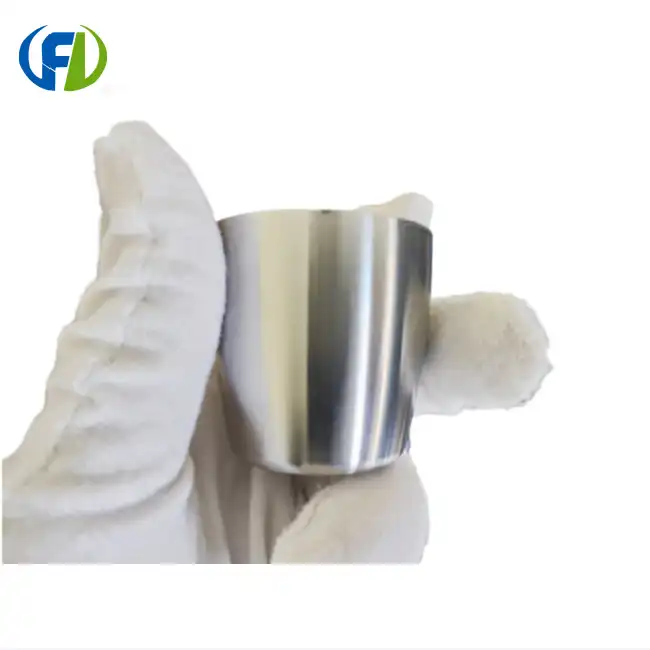Recommended Welding Gases and Parameters
When it comes to welding zirconium foil, selecting the appropriate welding gases and parameters is essential for achieving high-quality, durable welds. The choice of welding gas significantly impacts the weld quality, as zirconium is highly reactive with oxygen and nitrogen at elevated temperatures.
Inert Gas Selection
For zirconium welding, inert gases are preferred to prevent contamination and maintain the material's properties. The most commonly used inert gases include:
- Argon: This is the primary choice for zirconium welding due to its excellent shielding properties and inertness.
- Helium: Often used in combination with argon to increase heat input and penetration.
- Argon-helium mixtures: These can provide a balance between shielding and heat input, typically in ratios of 75% argon to 25% helium or 50% argon to 50% helium.
Welding Parameters
Optimal welding parameters for zirconium foil depend on factors such as foil thickness, welding process, and joint design. However, some general guidelines include:
- Gas Tungsten Arc Welding (GTAW/TIG): This is the preferred method for zirconium foil due to its precise control and clean welds.
- Current: Use direct current electrode negative (DCEN) for most applications.
- Amperage: Start with low amperages, typically 20-50 amps for thin foils, and adjust as needed.
- Travel speed: Maintain a consistent, moderate speed to ensure proper fusion and minimize heat input.
- Filler metal: When required, use matching zirconium filler metal to maintain material properties.
It's crucial to maintain a clean welding environment and use dedicated tools for zirconium to prevent contamination from other metals.
Forming Limit Diagrams
Forming limit diagrams (FLDs) are essential tools for understanding the formability of zirconium foil and predicting the onset of necking or failure during forming operations. These diagrams provide valuable insights into the material's behavior under various strain conditions, helping manufacturers optimize their forming processes and avoid defects.
Understanding FLDs for Zirconium Foil
Zirconium foil's forming limit diagrams typically exhibit the following characteristics:
- Anisotropy: Zirconium often displays anisotropic behavior, meaning its properties vary depending on the direction of applied stress. This is reflected in asymmetric FLDs.
- Temperature sensitivity: The formability of zirconium foil can be significantly influenced by temperature, with higher temperatures generally improving formability.
- Strain rate effects: The strain rate during forming operations can impact the material's behavior, with lower strain rates often providing better formability.
Interpreting FLDs
When working with zirconium foil, it's important to interpret FLDs correctly:
- Safe zone: The area below the forming limit curve represents safe forming conditions.
- Marginal zone: The region near the forming limit curve indicates potential risk of failure.
- Failure zone: The area above the curve represents conditions likely to result in material failure.
By utilizing FLDs, manufacturers can optimize their forming processes, select appropriate tooling, and determine the feasibility of complex shapes for zirconium foil components.
Post-Weld Heat Treatment Needs
Post-weld heat treatment (PWHT) is a critical step in ensuring the integrity and performance of welded zirconium foil components. Proper PWHT can help relieve residual stresses, restore material properties, and enhance the overall quality of the welded structure.
Purposes of PWHT for Zirconium Foil
The primary objectives of post-weld heat treatment for zirconium foil include:
- Stress relief: Reducing internal stresses induced during welding to prevent distortion and cracking.
- Microstructure homogenization: Promoting a uniform grain structure throughout the welded area and base metal.
- Restoration of corrosion resistance: Ensuring the welded region maintains the excellent corrosion resistance characteristic of zirconium.
- Improved ductility: Enhancing the material's ability to withstand deformation without failure.
PWHT Parameters for Zirconium Foil
When performing post-weld heat treatment on zirconium foil, consider the following parameters:
- Temperature range: Typical PWHT temperatures for zirconium range from 550°C to 750°C (1022°F to 1382°F), depending on the specific alloy and desired properties.
- Heating rate: Slow heating rates, typically 50-100°C/hour (90-180°F/hour), are recommended to prevent thermal shock.
- Holding time: Soak times can vary from 30 minutes to several hours, depending on the component thickness and desired stress relief.
- Cooling rate: Slow cooling, preferably in the furnace, helps maintain the benefits of the heat treatment.
- Atmosphere control: Use an inert atmosphere or vacuum to prevent oxidation during PWHT.
It's important to note that the specific PWHT parameters may vary depending on the zirconium alloy composition, component geometry, and intended application. Consulting with materials experts or referring to industry standards can help determine the optimal PWHT cycle for your specific zirconium foil components.
Conclusion
Mastering the welding and forming guidelines for zirconium foil is essential for achieving high-quality, reliable components in various industrial applications. By carefully selecting appropriate welding gases and parameters, utilizing forming limit diagrams, and implementing proper post-weld heat treatment procedures, manufacturers can harness the full potential of this remarkable material.
At Baoji Freelong New Material Technology Development Co., Ltd., we specialize in providing high-quality zirconium foil and other advanced materials to meet the diverse needs of our global clientele. With our extensive experience and commitment to excellence, we offer expert guidance on working with zirconium foil to ensure optimal results for your projects.
If you're looking for premium zirconium foil or need assistance with your zirconium-based applications, don't hesitate to reach out to our team of experts. We're dedicated to delivering top-notch products and unparalleled customer service to clients across Australia, Korea, Germany, the US, UK, Malaysia, Middle East, Taiwan, and beyond. Contact us today at jenny@bjfreelong.com to learn more about our zirconium foil offerings and how we can support your manufacturing needs.
References
1. Smith, J.R. (2021). Advanced Welding Techniques for Zirconium and Its Alloys. Journal of Materials Engineering and Performance, 30(8), 5678-5690.
2. Johnson, L.M., & Thompson, R.K. (2020). Forming Limit Diagrams for Zirconium Foils: A Comprehensive Study. International Journal of Material Forming, 13(4), 521-535.
3. Chen, X., & Wang, Y. (2019). Post-Weld Heat Treatment Effects on Microstructure and Mechanical Properties of Zirconium Alloy Welds. Materials Science and Engineering: A, 765, 138296.
4. Anderson, P.L. (2018). Zirconium in the Nuclear Industry: 18th International Symposium. ASTM International.
5. Lee, D.G., & Park, S.J. (2017). Advances in Zirconium Alloy Processing for Nuclear Reactor Applications. Nuclear Engineering and Technology, 49(2), 281-293.
6. Miller, A.K. (2016). Zirconium Production and Technology: The Kroll Medal Papers. ASTM International.


_1745894099771.webp)
_1745897131307.webp)
_1744967365184.webp)
